Where should I start? I stumbled onto the world of food blogs via Chowhound. Some of my favorite 'hounds had links to their blogs along with their posts, and I started reading through them. Many of them had beautiful pictures, and it brought back memories of my earlier days as a photo-journalist-in-training for a weekly online publication in college.
I'd gotten into photography because of my sister. As with all little sisters, I emulated my sister a lot and wanted to do all the cool things she did. When I was in grade school, she was in high school, doing the photography-thing. She had a nice Canon SLR, and boy, did I want one too! So, when I became old enough to save enough allowances, Xmas, New Years (Japanese tradition), and birthday gifts, I got my very own Canon SLR. It was called the EOS Kiss in Japan, which Canon named EOS Rebel when they brought it to the US. It's sort of interesting how the camera has a very 'cute' name in Japan and a very 'strong' name in the US... I wonder what the marketing strategies are behind that change...
Anyway, I started with the EOS Kiss, eventually upgrading to the EOS 100, also named differently in the US (no ideas on that one). I enjoyed taking pictures of various events, people, things, but never really had a theme. I dabbed with color some, but never got much beyond the typical high-school obsession with black and white photography... Then, came the digital photo age. I, being Japanese, love gadgets, and I upgraded my film SLR to a digital SLR, only to find myself not doing much with my digital SLR. All my lenses for the film camera work with my digital camera, and I had no excuse not to go out there and be creative with my photography. The problem was my lack of a "theme" - that drive to explore - that curiosity to look at life through the view finder for a more careful look at the world of colors, angles, and all sort of other visual stimulation...
My camera sat idle for a while, waiting for me to feel the love. And then, it happened. I went to Paris. My desire to capture the beautiful medley of colors was re-ignited. I was challenged and stimulated by the dishes I encountered in Paris. They smelled and tasted so good, but the peak of their performance was short-lived. Food, especially those culinary treasures we as a species have cultivated, have a relatively short window of time when it is best. Cold foods need to be consumed while cold, and hot food need to be consumed while hot. Even salads need to be eaten before the dressing unnecessarily wilts them! And the window for food photography is even shorter... I refuse to become so consumed with the photography aspect to neglect the food and miss its peak performance. Besides, food is most photogenic during that peak period... What a challenging and exciting art!
I blog to chronicle my experiences and discoveries with food, but the driving force behind my blog is my joy for food photography. I don't want my pictures to be simple snap shots of what I ate. I want my pictures to speak for themselves on how the object depicted stimulated me. I want them to recreate the sensation I felt when I encountered what you see in the photographs. And my words are here only to play a supporting role in that experience... So far, I've chosen not to directly describe the pictures in too much detail in my posts, since I wanted you to have an un-biased opinion/impression, but today, I'm trying something different...
So, with that, here are some recent shots from Yuzu in San Mateo...
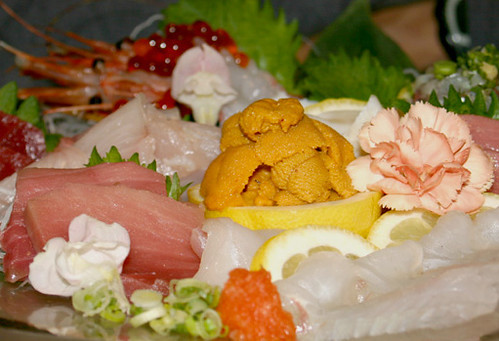
When I go to Yuzu, I always start with a sashimi platter. I find a meal with only sushi to be too filling to try the variety I'd like, so I get a sashimi platter with Chef Arima-san's recommendations. You see here a wide selection of seafood choices, including toro (fatty tuna), amaebi (sweet shrimp: raw shrimp), ikura (salmon roe), uni (sea urchin), kampachi (which is not the same as hamachi, as some websites will try to tell you... Even if you can't read the Japanese, you can see that these are two different fish from the pictures and the fact that they have different species names), tai, etc, etc. Although sashimi has a wider window of time for me to tinker with the pictures, the lack of a center piece/focus point, makes it hard for me to decide what I want to say through my sashimi pictures. This first one is about the luxury of choices.
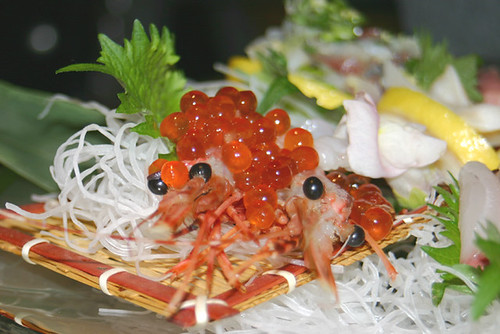
This second one is because I love ikura and these amaebi were particularly good that evening. This is more of an artistic food photo than a communicative food photo. I just thought the colors of the ikura, the shrimp, the daikon tsuma, and the shiso leaves were too gorgeous to not capture.
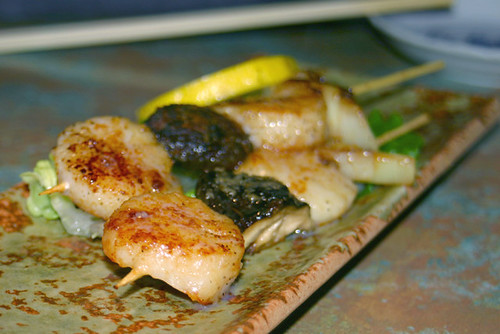
Then, here, we have the extra-succulent, tender sea scallop skewers. It had a layer of garlic paste and a nice grilled flavor to it. The fresh shiitake had the same texture as the scallops and they were luscious together. The sourness of the lemon put the various flavors right in focus, while also adding a splash of color to this picture.
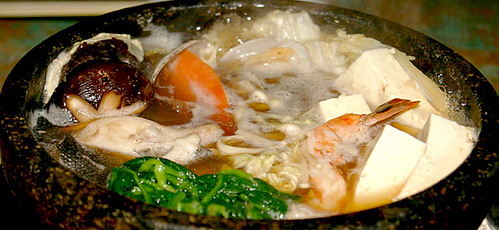
Here, we have the sizzling seafood hot pot in a bimbinbap bowl. These Korean bowls retain heat extremely well, allowing for the soup to stay hot the entire time. Although this dish has a lot of tasty seafood, the true star is the broth, which contains the various essence of all the ingridients in it. I could've dug out the ingridients more for the photo, but I captured the soup as it was presented to me - the soup sizzling and starring in the photo as the main character.
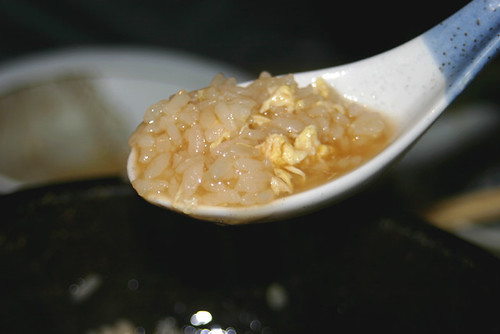
Once we finished the soup, they took the bowl back, filled it with rice and some more soup, and cooked it for a while with eggs for a zousui (porridge) finish. The key player of this dish is each individual rice grain, soaking in a hot bath of the tasty broth with eggs as its only companion. I tried to highlight each grain in its unbroken, wholesome state, shinning proudly as the closing act for the meal.
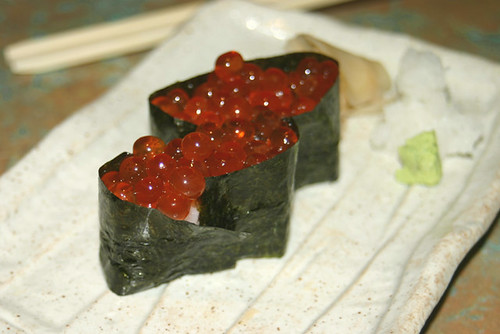
The true finale for my sushi visits, though, is always the ikura sushi. I can't go home without having a serving of ikura. Ikura is so beautiful - they are breath-taking in their deep glittery red, with a wonderful contrast against the black nori coat. This ikura sushi looks particularly intriguing, showing just a tad bit of its pale, white tenderness underneath the nori. This style of sushi is called a gunkan-maki (battle ship roll), since the tight nori wrap resembles battleships. Not in this case. This one hardly looks like a battleship, but rather, has the coquettish look of a Japanese high school girl in her black, red, and white uniform... Oh, I better stop that line of description before the Papa Bear accuses me of being 'dirty' again...
That's my two cents on what I tried to convey with my pictures.
5 comments:
those pictures are beautiful. I feel ashamed of taking mine with my low-res phone camera. But it's the only camera I always I never lose/forget/misplace.
okay, i change my mind.
nevermind ramen. _this_ is the best blog entry ever. EVAR.
btw, ino sushi in SF has the best ikura i've ever had in the bay area. the only other places i've had ikura as good were at urasawa in beverly hills and some tiny sushi joint i don't remember the name of near the tsukiji fishmarket in tokyo.
Talking about Ikura, I think Kitsho Sushi in Cupertino has the best hands down. Chef Howard marinated them himself so the taste is completely different from the ones you get anywhere else.
It is not as salty, but with subtle flavor of bonito, sake, soy sauce all bland together in perfect balance. Absolutely great with beer....
For the record, I hate Ikura in general. Kitsho is the only place where I will order it.
There is an old story about a child trying to move a heavy stone while his father looks on. The child works and works, but the little guy is just not strong enough. Finally, he gives up and tells his father, "I can't. It's impossible."
His father replies, "You can do it. You haven't used everything you have available to you yet." The little boy claims he has tried his hardest, and still can't do it, to which the father answers, "But you haven't asked me to help yet, have you?"
Dieting can often seem like moving that heavy rock. You fight and struggle, sweat and exercise, but it's so hard to stick to a diet and exercise schedule that you quit. There comes a time to recognize that asking for help is a sign of strength rather than weakness. Enlisting the aid of friends, family and a good weight loss support group can boost your efforts and help you overcome setbacks that threaten to derail your weight loss program. Instead of trying to diet alone, try a few of these suggestions to help you stay on track with the help of family and friends.
1. Find and work with an exercise buddy. Making a date and a commitment to help someone else's weight loss or exercise efforts will help you stick to yours. But you don't know anyone you can exercise with, you say? You might be pleasantly surprised. Several years ago, I was commiserating with an Internet friend about another failed effort to lose weight when she proposed a splendid idea. We each got a cell phone with the same calling plan, and every afternoon at 2:00, we "met" for a stroll. She did her walking in New Hampshire, and I did mine in Denver -- but by keeping each other company, we helped the other lose 25 pounds each, and created a friendship that will last a lifetime.
2. Get your family on the same page. Wives, husbands, kids and brothers and sisters can offer support in unexpected ways. Something as simple as a sincere compliment at the right time might be all you need to nudge you back on track. On that same token, refuse to let them sabotage your efforts. When you recognize negativity, point it out but keep in mind that they probably don't think of it as "sabotage" or negative influence. If your husband always brings you a bowl of ice cream when he makes one for himself, for example, he probably thinks he's expressing his love. Let him know you appreciate it, but you'd rather have a bowl of fruit or a kiss than ice cream anytime.
3. Join a weight loss group. There's a lot to be said for seeking out the support of others who are struggling withthe same battle you are. Whatever it is which motivates you, you can find it in a weight loss support group. Healthy competition, companionship, encouragement, approval, and practical, common sense advice from others who are also working to take off pounds can all make reforming your eating habits a lot easier.
THE ATKINS DIET
Obesity is the main reason for many diseases like cardiovascular problems, diabetes, depression, and sleep apnea. The only way out of this problem is to follow a strict and healthy diet. But that doesn’t mean avoiding food altogether for that it is not at all a good option since it would deprive our body of essential nutrients. Hence a controlled carbohydrate diet is advised for carbohydrate is mostly responsible for increasing one’s body weight.
The low carbohydrate Atkins Diet was first introduced in 1970’s by Dr. Robert Atkins. But it became popular almost 10 years later after the release of his book - ‘Dr. Atkins New Diet Revolution’ which went one to become one of the bestsellers of that decade. In no time, millions of people in the United States and abroad began to follow Atkins diet specifications as their first diet choice.
What is Atkins Diet?
Atkins Diet is a high protein, low carbohydrate diet. It promotes using meat, eggs, and cheese while discouraging high carbohydrate-content foods such as bread and rice. If excess carbohydrates are taken in, excess enzymes should be generated to digest it. This may lead to disintegration of pancreatic cells in a long run, which may further lead to diabetes. According to Robert Atkins, on having a low carbohydrate diet, our body will enter into a state of ketosis, in which, instead of carbohydrates, fat is digested to release energy. This reduces the need for more insulin produced by the pancreatic cells and the fat deposits are subsided. Thus, the body weight is reduced to a considerable amount.
Advantages of Atkins Diet:
1. Considerable amount of body weight is reduced by the burning of fats which is the secondary source of energy.
2. Inter-meal diets could be avoided since you won’t be hungry between meals.
3. Could maintain constant blood sugar level.
4. Since most of the toxins contained in our body are removed along with the burning of fats, overall heath is improved.
Things to Note:
1. It is recommended to consult a doctor or physician before trying out Atkins diet meal plans.
2. Daily exercise is highly recommended along with Atkins diet foods.
3. People with kidney disorders, pregnancy, and diabetes are advised not to follow Atkins diet meal plans.
Phases of Atkins Diet:
1. Induction - In this phase, which includes first 14 days of the diet, it is said that you will lose up to 15 pounds of your body weight. During this time, the amount of carbohydrates consumed per day will be less than 20 grams. The only carbohydrates included in your Atkins diet recipes will be low carbohydrate-content vegetables like tomato.
2. Ongoing Weight Loss – During this second stage, the consumption of carbohydrates is raised up to 5 grams per day.
3. Pre-maintenance – During this stage of Atkins diet meal plans, the rate of fall of body weight will be slower. Also, you can experiment various other foods to see whether they add your body weight or not. If found safe, you could add it to your Atkins diet food products.
4. Maintenance – You enter this phase when you find that you have reduced the body weight to the desired level. Also you could add some more carbohydrates to your diet which do not raise your body weight, like full wheat bread.
Tail Piece: The ultimate result of Atkins diet program (other diet programs as well) depends solely on how well the person follows the recommendations. Hence make sure that you follow it religiously.
Post a Comment